 W
W7,62 ITKK 31 VKT or 7,62 mm VKT anti-aircraft machine gun was the primary anti-aircraft machine gun of the Finnish Army during World War II. The weapon was designed by the Finnish gunsmith Aimo Lahti. 507 weapons were produced in two versions, 7,62 ItKk/31 VKT and an improved 7,62 ItKk/31-40 VKT, between 1933 and 1944.
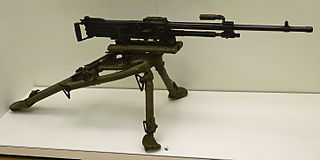 W
WThe Alfa M44 was a Spanish machine gun developed during World War II. At this time, stocks of machine guns ran low and no outside source was available. Non-combatant nations found that the belligerent nations were unable to supply as they were preoccupied with meeting their own wartime production needs. It complimented the ZB-26 light machine gun, and replaced the aging Hotchkiss M1914 machine gun. Originally chambered in 7.92×57mm Mauser, in 1955 an updated version chambered in 7.62×51mm NATO was introduced, and was subsequently issued to Spanish troops, sometimes referred to as the M55. Along with Spain, the M44 was also prominently used by Egypt, whose army had standardised on the 7.92×57mm Mauser round.
 W
WThe Besa machine gun was a British version of the Czechoslovak ZB-53 air-cooled, belt-fed machine gun.
 W
WThe Ciężki karabin maszynowy wz. 25 Hotchkiss was a Polish derivative of the Hotchkiss M1914 machine gun, rechambered for 7.92×57mm Mauser ammunition.
 W
WThe M1919 Browning is a .30 caliber medium machine gun that was widely used during the 20th century, especially during World War II, the Korean War, and the Vietnam War. The M1919 saw service as a light infantry, coaxial, mounted, aircraft, and anti-aircraft machine gun by the U.S. and many other countries.
 W
WThe Cugir machine gun is a gas-operated rotating bolt-locking medium machine gun, based on the Soviet PKM, used by Romanian Land Forces. It can be carried and operated by one person, but an assistant gunner is usually employed. It is available with either a 250-round belt or a 100-round box magazine.
 W
WThe Darne machine gun is a machine gun of French origin.
 W
WDS-39 was a Soviet medium machine gun, designed by Vasily Degtyaryov, that was used during the Second World War. The work on the gun's design began in 1930, and it was accepted by the Red Army in September, 1939. About 10,000 were made from 1939 to 1941, but the weapon was not successful in service and its production was discontinued after the German invasion began in June, 1941, with factories converted to produce the older, more reliable PM M1910. which was in turn replaced by the SG-43 Goryunov medium machine gun in 1943.
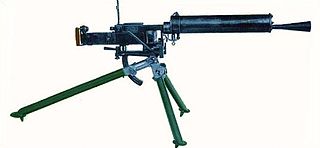 W
WThe Fiat–Revelli Modello 1914 was an Italian water-cooled medium machine gun produced from 1914 to 1918. It was the standard machine-gun of the Italian Army in World War I, and was used in limited numbers into World War II.
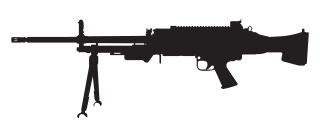 W
WThe Heckler & Koch MG5 is a belt-fed 7.62×51mm NATO general-purpose machine gun manufactured by German firearm manufacturer Heckler & Koch. The MG5 resembles the 5.56×45mm NATO Heckler & Koch MG4 light machine gun, which was adopted into German military service in 2005.
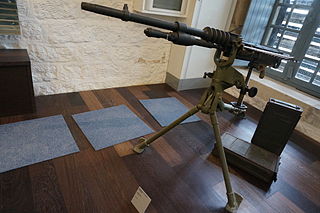 W
WThe Mle 1914 Hotchkiss machine gun chambered for the 8mm Lebel cartridge became the standard machine gun of the French Army during the latter half of World War I. It was manufactured by the French arms company Hotchkiss et Cie, which had been established in the 1860s by American industrialist Benjamin B. Hotchkiss. The gas-actuated Hotchkiss system was first formulated in 1893 by Odkolek von Ujezda and improved into its final form by Hotchkiss armament engineers, American Laurence Benét and his French assistant Henri Mercié.
 W
WL94A1 is the British Ministry of Defence designation for the long-barrelled version of the Hughes EX-34 7.62 mm chain gun, which is fitted to several British Army armoured fighting vehicles, including the Challenger 2 and the Warrior. A second version with a shorter barrel, designated L95A1, was also procured in small numbers.
 W
WThe M73 and M219 are 7.62 mm NATO caliber machine guns designed for tank use. NATO no longer uses them, but they were used on the M48 Patton and M60 Patton MBT series, as well as the MBT-70 prototype vehicles, and on the M551 Sheridan Armored Reconnaissance / Airborne Assault Vehicle (AR/AAV).
 W
WThe M240, officially the Machine Gun, 7.62 mm, M240, is the U.S. military designation for the FN MAG, a family of belt-fed, gas-operated medium machine guns that chamber the 7.62×51mm NATO cartridge.
 W
WThe M1919 Browning is a .30 caliber medium machine gun that was widely used during the 20th century, especially during World War II, the Korean War, and the Vietnam War. The M1919 saw service as a light infantry, coaxial, mounted, aircraft, and anti-aircraft machine gun by the U.S. and many other countries.
 W
WA medium machine gun (MMG), in modern terms, usually refers to a belt-fed machine gun firing a full-powered rifle cartridge, and is considered "medium" in weight. Medium machine guns are light enough to be infantry-portable, but still cumbersome enough to require a crew for optimal operational efficiency.
 W
WThe MG 45 was a machine gun based on the MG 42, which was developed but not fielded in significant numbers by the German Army in World War II.
 W
WThe 7.5 mm Maschinengewehr 1951 or Mg 51 is a general-purpose machine gun manufactured by W+F of Switzerland. The weapon was introduced into Swiss service when the Swiss Army initiated a competition for a new service machine gun to replace the MG 11 heavy machine gun and the Furrer M25 light machine gun adopted in 1911 and 1925 respectively.
 W
WThe Parabellum MG 14 was a 7.92 mm caliber World War I machine gun built by Deutsche Waffen und Munitionsfabriken. It was a redesign of the Maschinengewehr 08 machine gun system intended for use on aircraft and zeppelins. It used a toggle action that broke upwards rather than downwards, the opposite way to the MG 08, making for a much more compact receiver. The fusee spring was replaced with an internal spring design, the breech block was completely different and the spent cartridges dropped out the bottom of the receiver, rather than being ejected forward through a hole under the breech from the receiver. There appears to be no action or receiver parts interchangeable with the MG 08. The MG 08's belt-style ammunition feed was enclosed in a drum, the recoil casing was lightened and the cooling jacket was modified for air- instead of water-cooling. The rate of fire was 700 rounds/minute. The belt was reduced to 30 mm in width.
 W
WThe Perino Model 1908 was an early machine gun of Italian origin designed earlier in 1901 by Giuseppe Perino, an engineer. Perino's design apparently was the first Italian-designed machine gun, and in its original configuration weighed in at a heavy 27 kilograms (60 lb), which made it largely unsuitable to field utilization and apt only for fortifications; a lightened 1910 version brought the weight down to 15 kilograms (33 lb). The gun was nonetheless adopted by the Regio Esercito and saw some use alongside the Fiat-Revelli Modello 14 and the Maxim guns. It had a unique feed mechanism, with a hopper on the side of the gun filled with up to five twenty-round clips rather than being belt fed. This allowed the loader to constantly keep the gun at maximum capacity, meaning the gun crew never had to stop to reload.
 W
WThe PKP Pecheneg is a Russian 7.62×54mmR general-purpose machine gun. It is a further development and modification of the PK machine gun. It is said to be more accurate than all its predecessors due to a heavier, non-removable, forced-air-cooled barrel with radial cooling ribs and a handle which eliminates the haze effect from hot gases and keeps the barrel cooler, making the weapon more reliable. A steel jacket encloses the barrel to and runs up to the muzzle similarly to the Lewis machine gun provide forced air cooling. Low pressure created at the front of the jacket during firing draws cool air into the jacket through oval windows at the rear of the jacket. Furthermore, the weapon is capable of having a telescopic sight or other sights mounted on it, which increases its accuracy and effective range.
 W
WThe MAC mle 1931 machine gun, was a machine gun used in French tanks of the World War II era, as well as in fortifications such as the Maginot line. It is also sometimes known as the JM Reibel, from Jumelage de mitrailleuses, or Reibel twin-mounted guns and really refers to the specialized twin-mounting frame used in JM cloche cupolas on the Maginot Line fortifications, while MAC mle 1931 refers specifically to the gun. The JM twin-mounts were the standard emplacement for the mle 1931 in fixed fortifications, while tanks and other AFVs received single guns.
 W
WThe MG 3 is a German general-purpose machine gun chambered for the 7.62×51mm NATO cartridge. The weapon's design is derived from the World War II era MG 42 universal machine gun that fired the 7.92×57mm Mauser round.
 W
WThe Salvator-Dormus M1893 also known as Skoda M1893 was a heavy machine gun of Austro-Hungarian origin. It was patented by Archduke Karl Salvator of Austria and Count George von Dormus and was manufactured by Skoda Works Plzeň. The Salvator-Dormus was chambered in the 8x50mmR round fed from an overhead magazine and was water-cooled with an oil lubrication device. There was also a pendulum adjustment in the trigger mechanism that allowed the operator to select the cyclic rate of fire, anywhere from 180 to 250 rounds per minute. The M1893 was cheaper than the Maxim gun but was gradually replaced by the Schwarzlose MG M.07/12.
 W
WThe Maschinengewehr (Schwarzlose) M. 7, also known as the Schwarzlose MG, is a medium machine-gun, used as a standard issue firearm in the Austro-Hungarian Army throughout World War I. It was utilized by the Dutch, Greek and Hungarian armies during World War II. It was routinely issued to Italian colonial troops, alongside the Mannlicher M1895 rifle.
 W
WThe SG-43 Goryunov was a Soviet medium machine gun that was introduced during the Second World War. It was chambered for the 7.62×54mmR cartridge, and was introduced in 1943 as a replacement for the older M1910 Maxim machine guns. It was mounted on wheeled mounts, tripods and armored vehicles.
 W
WA revolver cannon is a type of autocannon, commonly used as an aircraft gun. It uses a cylinder with multiple chambers, like those of a revolver handgun, to speed up the loading-firing-ejection cycle. Some examples are also power-driven, to further speed the loading process. Unlike a rotary cannon, a revolver cannon has only a single barrel, thus its spun weight is lower. Automatic revolver cannons have been produced by many different manufacturers.
 W
WThe French St. Étienne Mle 1907 was a gas operated air-cooled machine gun in 8mm Lebel which was widely used in the early years of the First World War. The "St.Etienne Mle 1907" was not derived from the Hotchkiss machine gun. Instead it was an entirely different gas operated, blow-forward design borrowed from the semi-automatic Bang rifle of 1903. This Bang system was first transposed in 1905 to the French Puteaux APX Machine Gun which soon proved to be unsatisfactory. Then, two years later, the Mle 1907 "St-Étienne" machine gun followed as an improved redesign of the "Puteaux" machine gun. However the Mle 1907 "St-Étienne" was only a partial redesign: the original blow-forward gas piston, rack-and-pinion system, and bolt mechanism of the Mle 1905 "Puteaux" machine gun had all been kept only slightly modified inside the newer weapon. Eventually a total of over 39,700 "St-Étienne" Mle 1907 machine guns were manufactured between 1908 and late 1917. They were widely used by French infantry during the early part of World War I until their replacement by the more reliable Hotchkiss M1914 machine gun.
 W
WThe T24 machine gun was a prototype reverse engineered copy of the German MG 42 general-purpose machine gun developed during World War II as a possible replacement for the Browning Automatic Rifle and M1919A4 for infantry squads. The T24 was chambered for the .30-06 Springfield cartridge.
 W
WThe Type 80 is a general-purpose machine gun manufactured by Norinco in China, based on the Soviet PKM. The machine gun was certified for design finalisation in 1980 and entered the PLA service in the mid-1980s, specifically in 1983. The Type 80 was intended as a successor to the Chinese independently developed Type 67, doing well in tests conducted in the Chengdu Military Region before it was dropped and instead, opted to keep the Type 67 GPMG in use.
 W
WThe Vickers K machine gun, known as the Vickers Gas Operated or Gun, Machine, Vickers G.O. .303-inch in British service, was a rapid-firing machine gun developed and manufactured for use in aircraft by Vickers-Armstrongs. The high rate of fire was needed for the small period of time when the gunner would be able to fire at an attacking aircraft. The weapon was also adopted for land use during World War II.
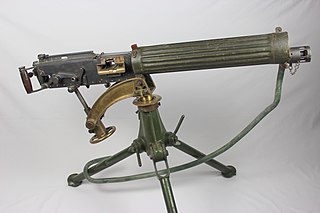 W
WThe Vickers machine gun or Vickers gun is a name primarily used to refer to the water-cooled .303 British (7.7 mm) machine gun produced by Vickers Limited, originally for the British Army. The machine gun typically required a six- to eight-man team to operate: one fired, one fed the ammunition, the rest helped to carry the weapon, its ammunition, and spare parts. Not to be confused with the Maxim machine gun, it was in service from before the First World War until the 1960s, with air-cooled versions of it on many Allied World War I fighter aircraft.
 W
WThe ZB-53 was a Czechoslovak machine gun. A versatile weapon, it was used both as a squad support weapon, as a mounted machine gun for tanks and other armoured vehicles, and on fixed positions inside Czechoslovak border fortifications. Adopted before the World War II by the armies of Czechoslovakia and Romania, it was also license-built in the United Kingdom as the Besa machine gun. Following the German invasion of Czechoslovakia, large quantities of the weapon were captured by the Wehrmacht and used during the war under the designation of MG 37(t).